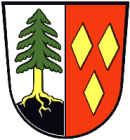|
|
| Statistics | |
|---|---|
| State: | Lower Saxony |
| Capital: | Lüchow |
| Adm. Region: | Lüneburg |
| Area: | 1220 km² |
| Inhabitants: | 51,800 (2002) |
| pop. density: | 42 inh./km² |
| Car identification: | DAN |
| Homepage: | http://www.luechow-dannenberg.de |
| Map | |
Lüchow-Dannenberg is a district in Lower Saxony, Germany. It is bounded by (from the west and clockwise) the districts of Uelzen and Lüneburg and the states of Mecklenburg-Western Pomerania (district of Ludwigslust), Brandenburg (district of Prignitz) and Saxony-Anhalt (districts of Stendal and Altmarkkreis Salzwedel).
| Contents |
History
In medieval times the counties of Lüchow and Dannenberg occupied the area (from the early 12th century on). These counties were originally Slavic states, that lost their independence to the duchy of Brunswick-Lüneburg in the beginning of the 14th century.
In medieval times the district's area was ruled by the duchy of Brunswick-Lüneburg resp. its partial states. There were two independent counties, which were originally Slavic states, that lost their independence to the dukes in the beginning in 1303.
The area was ruled by Lüneburg until 1705 and became then a part of the duchy of Hanover. When Hanover was annexed by Prussia (1866), the districts of Lüchow and Dannenberg were established.
In 1932 the two district Lüchow and Dannenberg were merged into the current district.
Current issues
Since the end of the 1990s the financial problems of the communes in the district grew more and more severe. To save money spend for administration a major communal reform is currently discussed. The two most likely outcomes of the reform would be either a conversion of the district to a urban district, in which the 27 municipalities will then become boroughs of one town. The other discussed solution is the merger into two Samtgemeinden. Also the dissolving of the district and inclusion of the two remaining Samtgemeinden into the districts Lüneburg and Uelzen are discussed.
Geography
The district is named for the two main towns. It is better known as the Wendland, a designation referring to the Slavic people of the Wends, who lived there till the 18th century - the last known user of the local dialect of Polabian language died in 1752. The landscape is characterised by riverside woodlands along the Elbe river and a hilly countryside.
In addition the Wendland is known for the tiny village of Gorleben, where a disposal place for radioactive waste was established. Gorleben is a site of clashes between the police and protesters since the 1980s.
Coat of arms

|
The coat of arms displays:
|
Towns and municipalities
| Towns | Samtgemeinden |
|---|---|
External link
- Official website (http://www.luechow-dannenberg.de) (German)
Template:Germany districts lower saxonyde:Landkreis Lüchow-Dannenberg nl:Lüchow-Dannenberg

